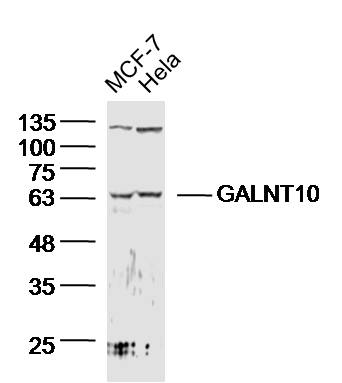GALNT10 Rabbit pAb
GALNT10 Rabbit pAb
- 产品详情
- 实验流程
- 背景知识
Application
| WB |
|---|---|
| Primary Accession | Q86SR1 |
| Reactivity | Rat, Pig, Chicken, Horse |
| Host | Rabbit |
| Clonality | Polyclonal |
| Calculated MW | 68992 Da |
| Physical State | Liquid |
| Immunogen | KLH conjugated synthetic peptide derived from human GALNT10/GalNAc-T10 |
| Epitope Specificity | 151-250/603 |
| Isotype | IgG |
| Purity | affinity purified by Protein A |
| Buffer | 0.01M TBS (pH7.4) with 1% BSA, 0.02% Proclin300 and 50% Glycerol. |
| SUBCELLULAR LOCATION | Golgi apparatus membrane. |
| SIMILARITY | Belongs to the glycosyltransferase 2 family. GalNAc-T subfamily. Contains 1 ricin B-type lectin domain. |
| Important Note | This product as supplied is intended for research use only, not for use in human, therapeutic or diagnostic applications. |
| Background Descriptions | The UDP-N-acetyl-alpha-D-galactosamine:polypeptide N-acetylgalactosaminyltransferase (GalNAc-T) family of enzymes are substrate-specific proteins that catalyze the transfer of GalNAc (N-acetylgalactosaminyl) to serine and threonine residues of various proteins, thereby initiating mucin-type O-linked glycosylation in the Golgi apparatus. GalNAc-T10 (Polypeptide N-acetylgalactosaminyltransferase 10), also known as UDP-GalNAc:polypeptide N-acetylgalactosaminyltransferase 10, is a 603 amino acid single-pass type II membrane protein that prefers Muc5Ac and EA2 peptide substrates. The N-terminal domain is involved in substrate binding and manganese coordination, while the C-terminal domain is involved in UDP-Gal binding and catalytic reaction. GalNAc-T10 is widely expressed, with highest levels found in small intestine. There are four isoforms of GalNAc-T10 that are produced as a result of alternative splicing events. |
| Gene ID | 55568 |
|---|---|
| Other Names | Polypeptide N-acetylgalactosaminyltransferase 10, 2.4.1.41, Polypeptide GalNAc transferase 10, GalNAc-T10, pp-GaNTase 10, Protein-UDP acetylgalactosaminyltransferase 10, UDP-GalNAc:polypeptide N-acetylgalactosaminyltransferase 10, GALNT10 |
| Target/Specificity | Widely expressed. Expressed at high level in small intestine, and at intermediate levels in stomach, pancreas, ovary, thyroid gland and spleen. Weakly expressed in other tissues. |
| Dilution | WB=1:500-2000 |
| Storage | Store at -20 °C for one year. Avoid repeated freeze/thaw cycles. When reconstituted in sterile pH 7.4 0.01M PBS or diluent of antibody the antibody is stable for at least two weeks at 2-4 °C. |
| Name | GALNT10 |
|---|---|
| Function | Catalyzes the initial reaction in O-linked oligosaccharide biosynthesis, the transfer of an N-acetyl-D-galactosamine residue to a serine or threonine residue on the protein receptor. Has activity toward Muc5Ac and EA2 peptide substrates. |
| Cellular Location | Golgi apparatus membrane; Single- pass type II membrane protein |
| Tissue Location | Widely expressed. Expressed at high level in small intestine, and at intermediate levels in stomach, pancreas, ovary, thyroid gland and spleen. Weakly expressed in other tissues |
For Research Use Only. Not For Use In Diagnostic Procedures.
Provided below are standard protocols that you may find useful for product applications.
BACKGROUND
The UDP-N-acetyl-alpha-D-galactosamine:polypeptide N-acetylgalactosaminyltransferase (GalNAc-T) family of enzymes are substrate-specific proteins that catalyze the transfer of GalNAc (N-acetylgalactosaminyl) to serine and threonine residues of various proteins, thereby initiating mucin-type O-linked glycosylation in the Golgi apparatus. GalNAc-T10 (Polypeptide N-acetylgalactosaminyltransferase 10), also known as UDP-GalNAc:polypeptide N-acetylgalactosaminyltransferase 10, is a 603 amino acid single-pass type II membrane protein that prefers Muc5Ac and EA2 peptide substrates. The N-terminal domain is involved in substrate binding and manganese coordination, while the C-terminal domain is involved in UDP-Gal binding and catalytic reaction. GalNAc-T10 is widely expressed, with highest levels found in small intestine. There are four isoforms of GalNAc-T10 that are produced as a result of alternative splicing events.
终于等到您。ABCEPTA(百远生物)抗体产品。
点击下方“我要评价 ”按钮提交您的反馈信息,您的反馈和评价是我们最宝贵的财富之一,
我们将在1-3个工作日内处理您的反馈信息。
如有疑问,联系:0512-88856768 tech-china@abcepta.com.























 癌症的基本特征包括细胞增殖、血管生成、迁移、凋亡逃避机制和细胞永生等。找到癌症发生过程中这些通路的关键标记物和对应的抗体用于检测至关重要。
癌症的基本特征包括细胞增殖、血管生成、迁移、凋亡逃避机制和细胞永生等。找到癌症发生过程中这些通路的关键标记物和对应的抗体用于检测至关重要。 为您推荐一个泛素化位点预测神器——泛素化分析工具,可以为您的蛋白的泛素化位点作出预测和评分。
为您推荐一个泛素化位点预测神器——泛素化分析工具,可以为您的蛋白的泛素化位点作出预测和评分。 细胞自噬受体图形绘图工具为你的蛋白的细胞受体结合位点作出预测和评分,识别结合到自噬通路中的蛋白是非常重要的,便于让我们理解自噬在正常生理、病理过程中的作用,如发育、细胞分化、神经退化性疾病、压力条件下、感染和癌症。
细胞自噬受体图形绘图工具为你的蛋白的细胞受体结合位点作出预测和评分,识别结合到自噬通路中的蛋白是非常重要的,便于让我们理解自噬在正常生理、病理过程中的作用,如发育、细胞分化、神经退化性疾病、压力条件下、感染和癌症。






